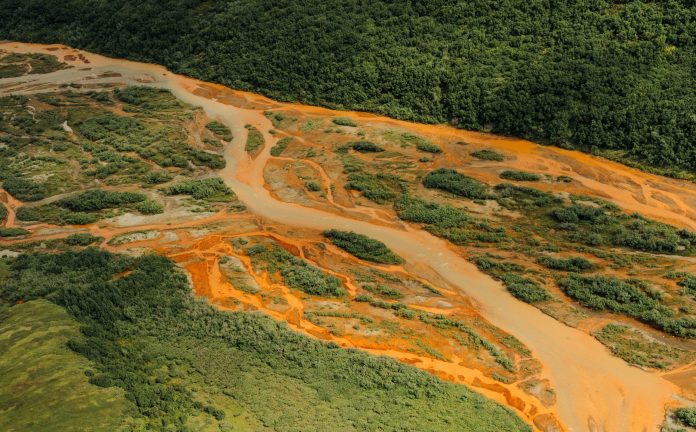The Alarming Changes in Alaska’s Brooks Range: What’s Happening to the Salmon River?
Have you ever thought about how a changing climate affects the world around us? Deep in Alaska’s majestic Brooks Range, a surprising and alarming transformation is taking place. The Salmon River, once so clear you could drink from it, is now running a rusty orange. This isn’t just a simple change in river color; it hints at deeper issues that could affect the entire ecosystem and local communities. Let’s dive into what’s going on and why it matters.
Warming Permafrost and Unleashing Toxins
Every year, our planet gets a little warmer. This warming is leading to the thawing of permafrost—soil that has been frozen for thousands of years. When this soil thaws, it doesn’t just melt away. Instead, it starts to release harmful chemicals into rivers. In the case of the Salmon River, scientists have found that acid is being created through a chemical reaction involving sulfide-rich rocks. This nasty acid is leaching heavy metals like iron, cadmium, and aluminum into the water.
It’s fascinating—yet troubling—to think that a river famous for its pristine beauty is now marred by these toxic elements. Can you imagine walking along its banks and witnessing this drastic change? Tim Lyons, a biogeochemist from the University of California, Riverside, explains that this phenomenon looks like acid mine drainage but is happening without any mining activity. It’s a stark reminder of how interconnected our environment is.
Research Highlights the Warnings
A recent study published in the Proceedings of the National Academy of Sciences emphasizes the severity of the situation. This isn’t just a local issue; changes like these are already occurring in many other rivers and watersheds in the Arctic.
David Cooper, a research scientist at Colorado State University, has been exploring the Brooks Range since 1976. He describes the recent alterations to the land and its water chemistry as “truly astounding.” The stakes couldn’t be higher. As researchers investigate, they discover that the intricate balance that keeps the river healthy is seriously under threat.
A Personal Encounter with Change
Imagine conducting fieldwork in these majestic forests, only to be told by a pilot that the Salmon River looks like “sewage.” That’s what happened to ecologist Paddy Sullivan from the University of Alaska. His mission was to study how Arctic forests were shifting northward due to climate change. However, the unexpected state of the river diverted his attention to a possible greater threat.
This feeling of alarm can resonate with anyone who’s worked hard in a particular area, only to witness it transforming before your eyes. Unfortunately, Sullivan’s findings confirmed the alarming observations. Not only is the water’s appearance concerning, but the chemical reactions triggered by thawing permafrost could have long-lasting effects on local wildlife.
Impacts on Local Wildlife
You may wonder, what does this mean for fish and other animals? Well, the Salmon River is a vital habitat for various fish species, including chum salmon, which many Indigenous communities depend on for food. Unfortunately, the introduction of heavy metals and reduced light in the water are major obstacles for these fish.
Less light in the river means fewer insects that salmon rely on as a food source. Furthermore, increases in certain metals can be harmful, particularly cadmium, which can accumulate in fish organs. The ripple effect extends beyond fish to bears and birds that eat them. The balance of life that has existed for generations is in jeopardy.
A Universal Warning
Lyons emphasizes that this isn’t just an issue confined to the Salmon River. Wherever permafrost is thawing, there’s potential for similar problems. Unlike traditional mining sites, remote rivers in these regions have no effective way to mitigate contamination. Once the chemical reactions are set in motion, they are almost impossible to reverse. It’s like opening a floodgate with no way to close it.
These findings raise questions about how the changes in these remote areas might impact communities and ecosystems downstream. What will happen when this ripple of change reaches species that humans rely on for food or economic activity?
Preparing for the Future
The challenges presented by this situation are profound. The study funded by the National Science Foundation aims to help communities and policymakers anticipate and prepare for these unavoidable changes.
As communities around the world grapple with climate change impacts, the story unfolding in Alaska serves as a stark reminder of what is at risk. It’s not just about environmental conservation; it’s about the survival and well-being of communities that have thrived in harmony with nature for centuries.
Conclusion: A Call to Acknowledge and Act
This alarming transformation in the Salmon River represents more than just a change in water color. It highlights a global issue that ties back to our actions, beliefs, and responsibilities toward the environment. The developments in Alaska scream out a truth we can no longer ignore—climate change is real, and it’s affecting us all, even in places far removed from urban life.
As we step back and reflect, let’s consider the lessons we can learn. What can we do to create change? It begins with awareness, education, and action—not just on a local level but also a global one. Each of us has a role to play in addressing climate change and preserving the intricate tapestry of life on our planet.
If we fail to heed these warnings, we risk losing not just beautiful landscapes like those of Alaska but also the vital ecosystems that sustain us. We must act now, or we may find ourselves wondering what we lost while we sat idly by and watched it happen. The rivers, fish, and communities of the future depend on our choices today.

